When I was growing up in the late 1960’s/early ‘70’s, you could always tell what the current national paperback bestsellers were simply by taking a trip to my household bathrooms and aiming a glance at the paperbacks left by my mom and older sisters (complete with dog-eared placemarkers) atop the toilet tank lid. Jacqueline Suzanne, Arthur Hailey, Irving Wallace and Harold Robbins made constant rotation with the occasional John Toland, John Barth or James Michener leviathans that took up a little extra space and (ahem) reading time. By the time this film-obsessed tyke got around to absorbing something other than issues of Castle Of Frankenstein or Famous Monsters Of Filmland magazine, my first contributions to the “family library” consisted of published screenplays of William Goldman and the first few paperbacks of Michael Crichton (under his own name), THE ANDROMEDA STRAIN (1969) and THE TERMINAL MAN (1972). At ages 6 and 8, respectively, I found the spare, cinematic style of Crichton’s writing extremely inviting, the paranoid man-against-nature-against-technology scenarios gripping and plausible. The parade of great moral questions that glazed these adventures in pulp contrivance proved to be my introduction to complex discussion about the world we live in (and not about film or Saturday morning TV programming) – once the bowl had been flushed, of course.
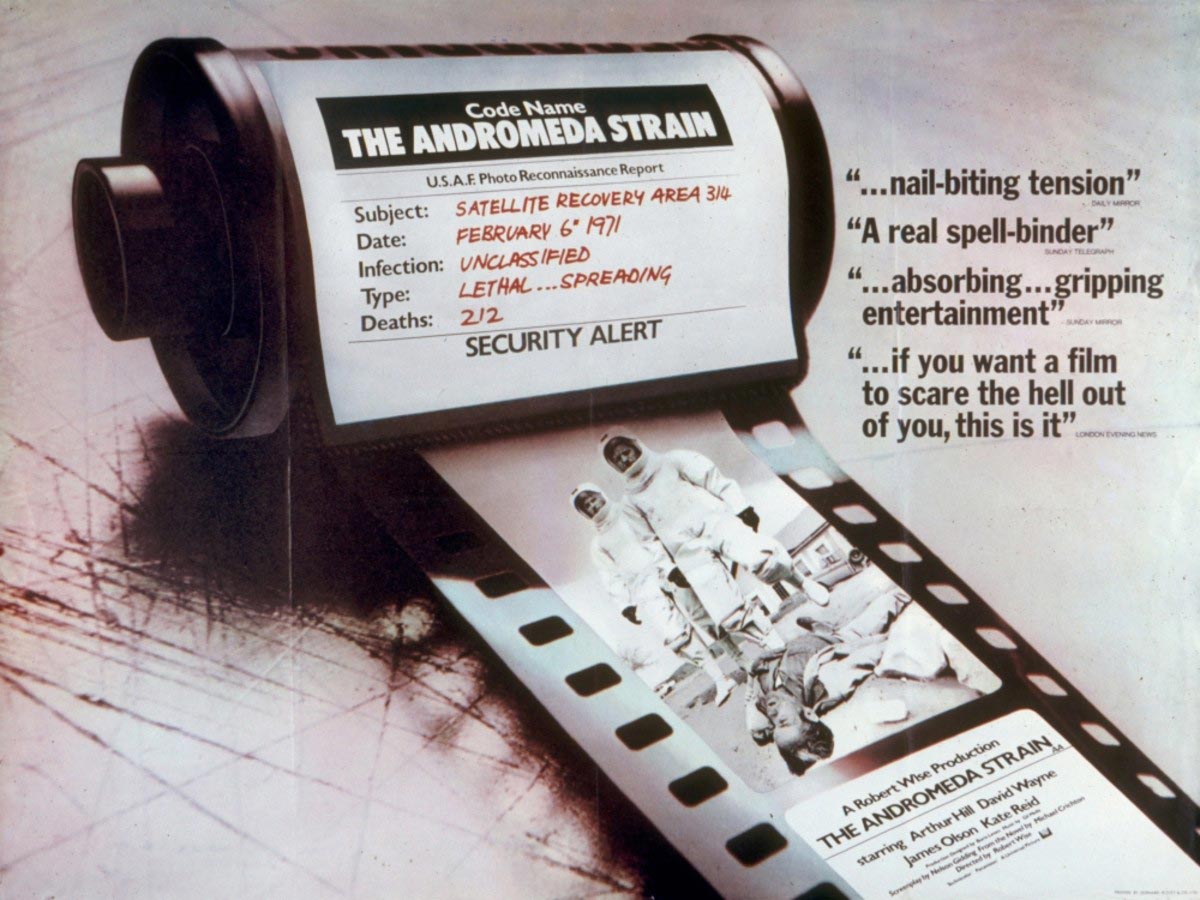
The film adaptations of both ANDROMEDA STRAIN and TERMINAL MAN came about within two years of each book’s initial publication and, while, superficially, the films are predominantly faithful to their source material, on closer examination, they also reveal an even tighter relationship to their directors’ individual body of work. Robert Wise, a former editor (CITIZEN KANE, THE MAGNIFICENT AMBERSONS), was a clean, uncluttered, unpretentious director who, for his entire career, preoccupied himself with stories that depict various forms of “invasion”. Whether it be personal space (THE CURSE OF THE CAT PEOPLE, I WANT TO LIVE) or international space (RUN SILENT, RUN DEEP, THE SAND PEBBLES) or institutional space (THE CAPTIVE CITY, EXECUTIVE SUITE) or cultural space (WEST SIDE STORY, THE SOUND OF MUSIC) or spiritual space (THE HAUNTING, AUDREY ROSE) or outer space (STAR TREK THE MOTION PICTURE, THE DAY THE EARTH STOOD STILL), Wise’s dramas are usually straight-forward, in-your-face cautionary tales about the reasons for and the repercussions of invasion. It’s easy to see how Wise would be centrifugally drawn to Crichton’s ANDROMEDA STRAIN – it seems to embody a bit of “all of the above”. Wise and screenwriter Nelson Gidding keep the complexities of the storyline (a team of scientists fighting against time to contain a dangerously mutating extraterrestrial organism before it spreads and destroys all life on earth) on a simple, suspenseful, forward-moving course. Part of the success of this simplicity is the casting of “non-star” character actors in the no-nonsense leads, the majority of whom are over 50 years of age and play well-drawn characters with a common goal (under-the-gun scientific detective work) and not a single romantic sub-plot to hold them back or slow them down. Wise’s film is a streamlined ode to scientific process and progress – if man has seven layers of skin, under what layer rests the key to survival? The film plays like a densely sandwiched sci-fi Grand Guignol – a ghoulish and grim, thoughtful and humanistic, intimate yet massively ornate chamber piece – everyday inter-personal tensions crunched amidst extraordinary scientific charts and codes, computer programs, labyrinthine underground biohazard facilities, obsessive cleanliness procedures and time-sensitive self-destruct systems. The shooting script (called a CineScript by Gidding and Wise) went to graphic lengths to illustrate an authentic world of top secret government paper trails and infinite levels of scientific security measures. Special effects pioneer Douglas Trumbull (2001:A SPACE ODYSSEY, SILENT RUNNING) augments master production designer Boris Leven’s meticulously logical (yet playfully color-coded) sets with an equally believable, mutable and threatening microscopic antagonist. Wise’s creative team is as clear-headed in their respective chores as the team of scientists depicted in Crichton’s novel. The efficiency and meticulous execution of detail that characterize the scientific team in the story can be seen as a reflection of the film unit gathered to complete a gargantuan studio production in time for successful holiday release. Wise and company, like ANDROMEDA’s characters, pull everything off in the nick of time – and save the world.
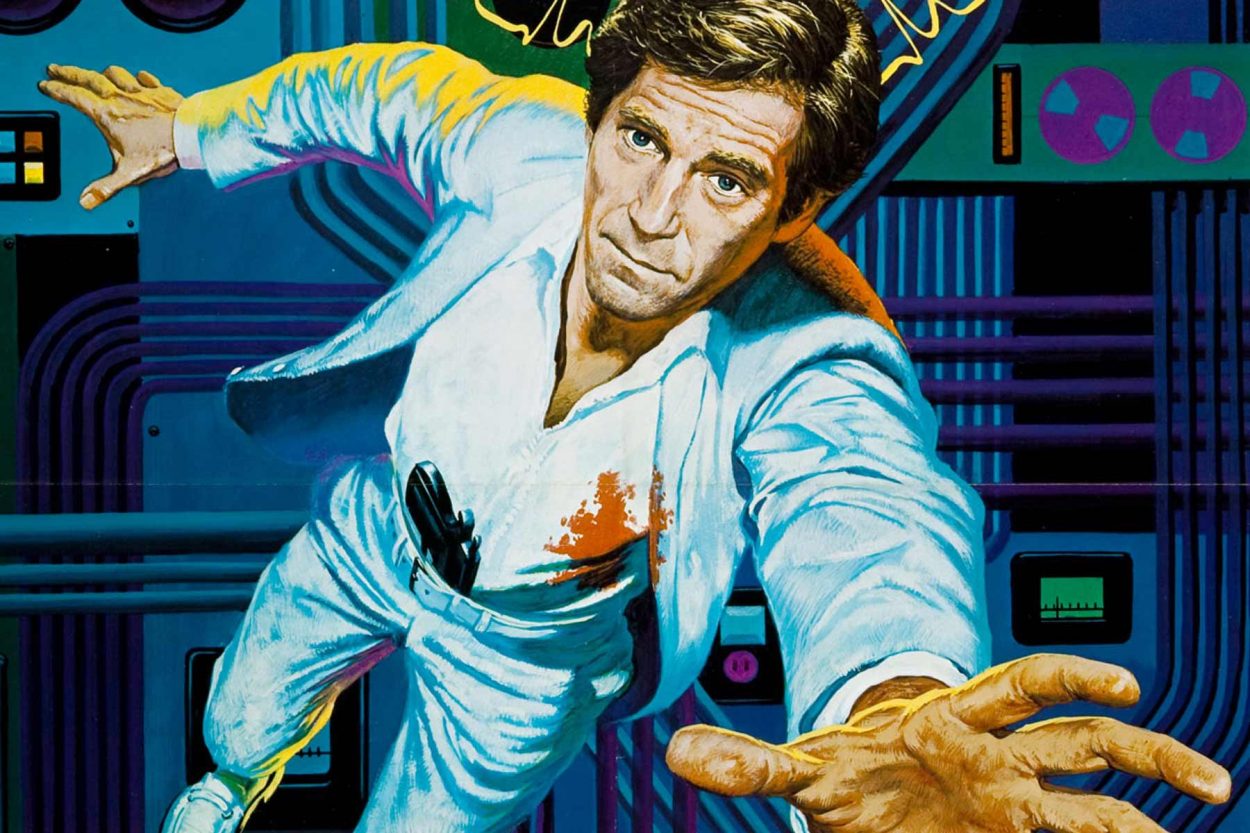
In contrast, Mike Hodges, the director of THE TERMINAL MAN, sharpens the edge of all the Crichton-esque bio-techno-authenticity with satiric punchlines and caustic character asides that recall the most vitriolic of Altman or Richard Lester. This was a developing style for Hodges as evidenced in his earlier GET CARTER and PULP.
THE TERMINAL MAN tells the story of a scientist, Harry Benson, (played by George Segal) who is working on artificial intelligence experiments and suffers a brain injury that sets off a series of increasingly violent episodes and paranoia of machines taking over the world. Ironically, Benson submits to an experimental surgery that would implant electrodes into his brain and, when the violent urges emerge, will stimulate the damaged area into calm pacification. Of course, Benson’s brain becomes addicted to the calming sensations at a freakishly accelerated pace, soon inciting more violent episodes than can be stopped by the computer. Hodges film doesn’t yearn to provide a celebration of collaboration and efficiency (as does Wise’s ANDROMEDA), its purpose is to coolly, calmly unseat public trust in professions of crucial civic importance (science, medicine, police). What good is attempting progress when human nature constantly ignores the rules? Whereas Wise tilled vulnerable surfaces to uncover character intimacy and nuance, Hodges believes that society is built upon impenetrable yet reflective surfaces that only seem to accurately mirror the flaws in the system when those images are shattered or fragmented. Every man is an island. Vain. Indulgent. Lustful. Greedy. Where Wise’s world extends to epiphany from under the seven layers of skin, Hodges’ world is dwarfed by the Seven Deadly Sins. Hodges is the cynical Ying to Wise’s optimistic Yang.
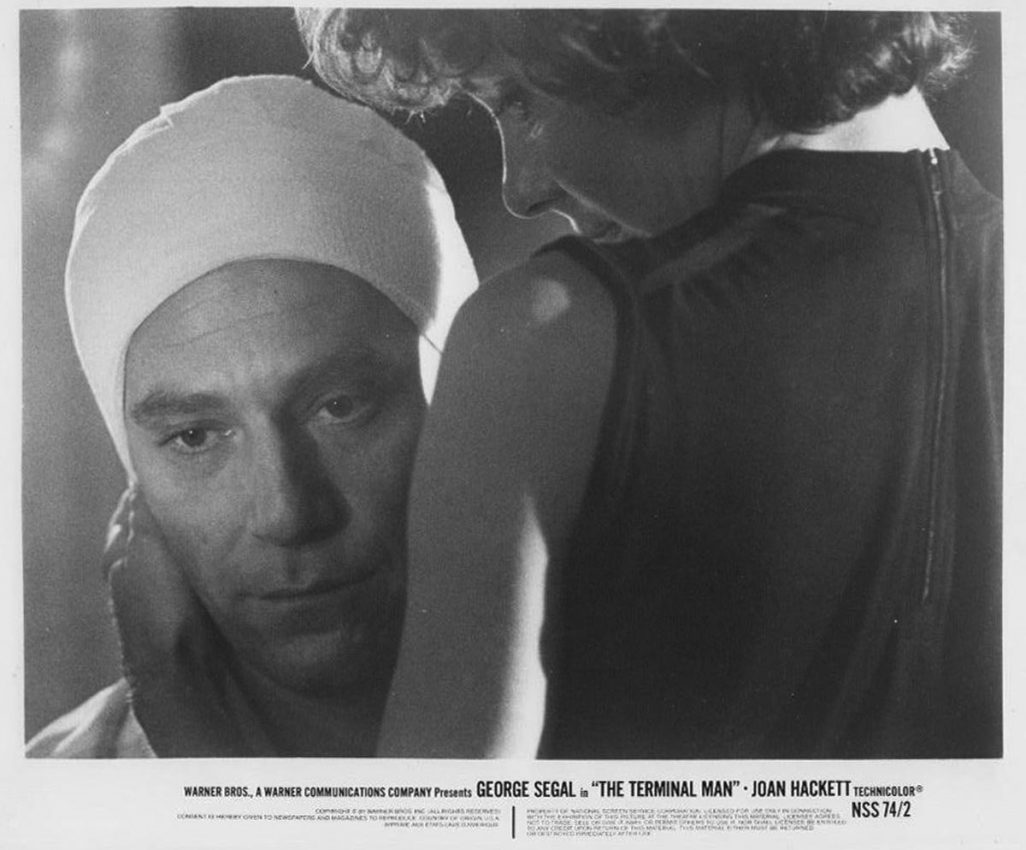
To underline Hodges’ cynicism, his production design is zapped of any colors aside from human flesh tones, flower petals, the occasional sliver of lawn and sky and, literally, rivers of blood. It’s a slyly cinematically referential world with nods to Hitchcock’s PSYCHO (shower scene), cautionary 1950’s sci-fi B-movies (a clip from Gordon Douglas’ classic THEM), Welles’ CITIZEN KANE (snowglobe paperweight and Cockatoo both figure in the main murder set-piece) and mirrors, mirrors, mirrors as well as a dip into canted angles and crushing, symbolic shadowy locations and sets of German Expressionism. In counterpart to the production styles, Hodges, like Wise, uses actors who, aside from George Segal, are mainly character actors. Even so, Segal (who at this point in his career had been selling himself as a brash, self-deprecating comic lead performer) allows Hodges to have him suck all posturing mannerisms inward so that he becomes sympathetic, mysterious, and balls-out terrifying when his character flies into rage after uncontrollable rage.
All this is (again, ironically, satirically) counterpointed by Hodges with Glenn Gould’s soothing performance of Bach’s Goldberg Variations as the soundtrack score – a sharp departure from Gil Mellé’s pulsing, chirping, multi-layered experimental electronic score for ANDROMEDA STRAIN. Both scores are perfectly reasoned and integrated for maximum effect, and both cling to the memory with similar menace.
What’s unifying between the two films is cinematographer Richard H. Kline. Kline is the son of Ben Kline, who shot DETOUR for Edgar Ulmer, several silents for John Ford, and decades upon decades of top television shows – close to 375 credits. Richard spent nearly 20 years as a contract cameraman for Columbia Pictures working under such unique talents as Philip Lathrop and Burnett Guffey – but mainly churning out dependably entertaining B-pictures for the Sam Katzman unit. He then moved himself up and out on his own to become one of the most versatile and adventurous cinematographers of the 60’s, ‘70’s and ‘80’s, specializing in films by Robert Wise, Richard Fleischer and Michael Winner, as well as reinventing the film noir with extraordinary color work on BODY HEAT and the Jim McBride remake of BREATHLESS. It’s most likely that Kline was chosen to lens ANDROMEDA because of his creative utilization of the split-screen process in Fleischer’s THE BOSTON STRANGLER (1968). The split-screen process is used aggressively throughout ANDROMEDA STRAIN to equally chilling effect. Another possible motive for using Kline was his active practice of split-diopter photography.
To quote the definition on VashiVisuals.com:
A Split Focus Diopter is a half convex piece of glass that attaches to the front of a camera’s main lens to make half the lens nearsighted. This lens can focus on a plane in the background and on a foreground element at the same time. To effectively apply this cinematographer’s tool a filmmaker has to plan out each shot so that both the foreground and background elements will be in focus. The Spilt Focus Diopter creates a hyper-real visual effect that logically shouldn’t happen but somehow it magically delivers a striking and visceral image that resonates in the mind of the viewer. SPLIT DIOPTER shots are most often attributed to Brian De Palma but director Robert Wise incorporated them into many of his films as a visual style and storytelling device, often using them more than 100 times in one film.
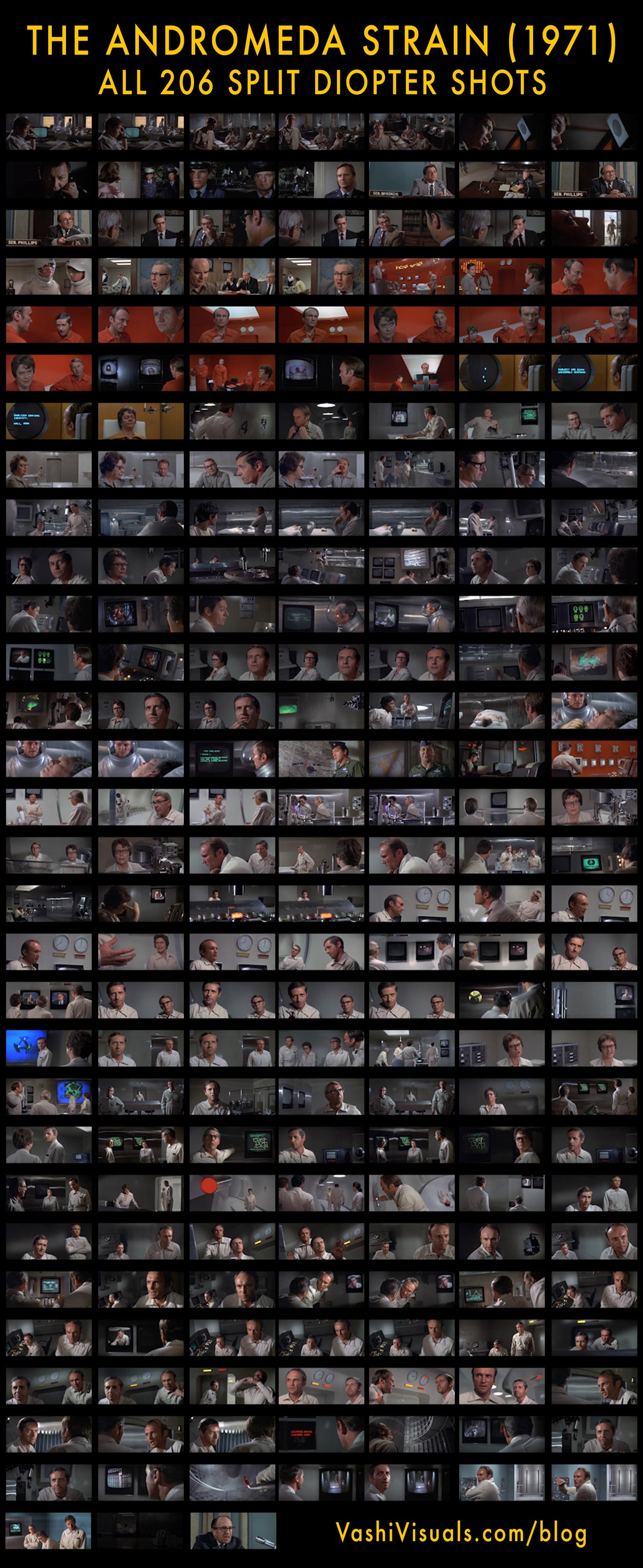 Photo by VashiVisuals.com
Photo by VashiVisuals.com
His split diopter shots became an integral part of the story and not just a stand-alone visual trick. In THE ANDROMEDA STRAIN, Robert Wise used 206 split diopter shots…the most in any feature film I’ve researched… Wise and Kline hid many split diopter shots that separated the focal planes by utilizing the monochromatic walls of the laboratory. The pure white, orange and gray walls were perfect for blending the in-focus and out of focus splits of the diopter. They also created several Double Split Diopter shots that created 3 zones of focus. I had never seen this technique used before and it created quite striking visuals.
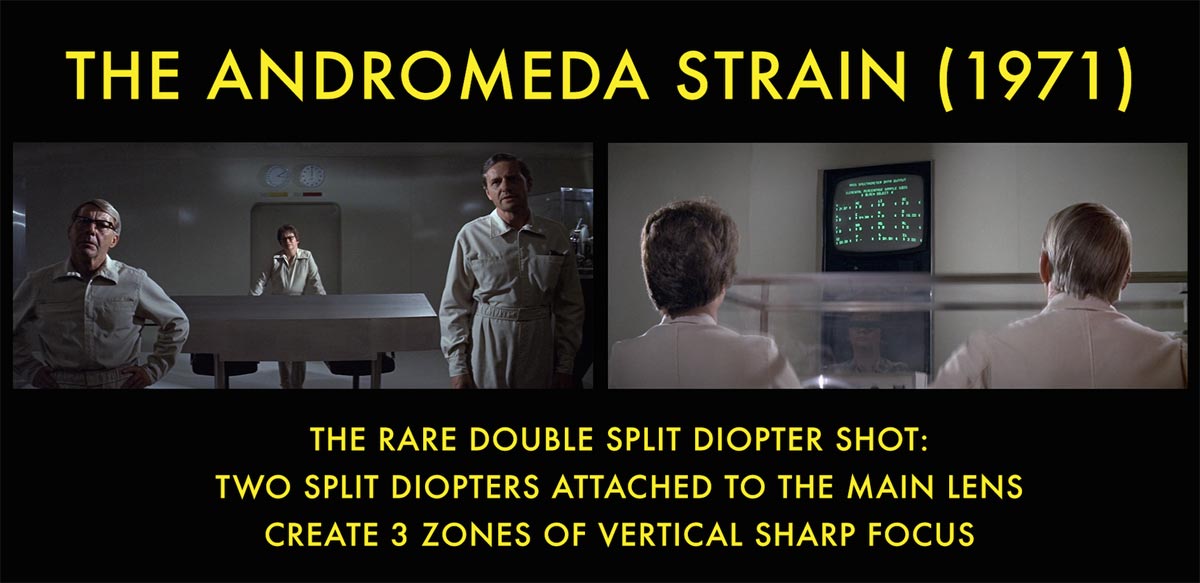 Photo by VashiVisuals.com
Photo by VashiVisuals.com
As a note: Kline was later asked to shoot THE FURY for De Palma.
One of the greatest moments of my movie-watching life was having Kline over to my home and studying a near-flawless German blu-ray of ANDROMEDA STRAIN with him, his personal commentary provided throughout. He’s not one to pour over his accomplishments for the sake of preserving his ego, but he is (at 90+) an extraordinary teacher who shares his experiences freely and with no small appreciation for the generosity and invention of his collaborators. ANDROMEDA confirmed an already growing industry reputation for Kline, but his work on Hodges’ TERMINAL MAN gained further validation in the industry – in a letter to Hodges by a screenwriter-recently-turned-director that pretty much sums it all up:
“Dear Mr. Hodges,
I have just come from seeing “The Terminal Man” and I want you to know what a magnificent, overwhelming picture it is. You achieve moods that I’ve never experienced in the movies before, though it’s only in hope of finding them that I keep going. Your images make me understand what an image is, not a pretty picture but something that should pierce one through like an arrow and speak in a language all its own. Which is perhaps why I cannot say just what it meant to see George Segal stumbling into the mausoleum at Forest Lawn or crushing the rose in his hands. Still, even if I can’t, I felt in those moments (and countless others) that I knew just what sadness is, and just how one’s life can slip away or go bad, and just what it’s like to be here, unrequired, on the earth. I’m running on, I guess, but don’t let that diminish my credibility. You must understand what a rare, extraordinary thing you’ve done, after all.
My wife, reading over my shoulder, echoes all these feelings.
Sincerely, Terry Malick”
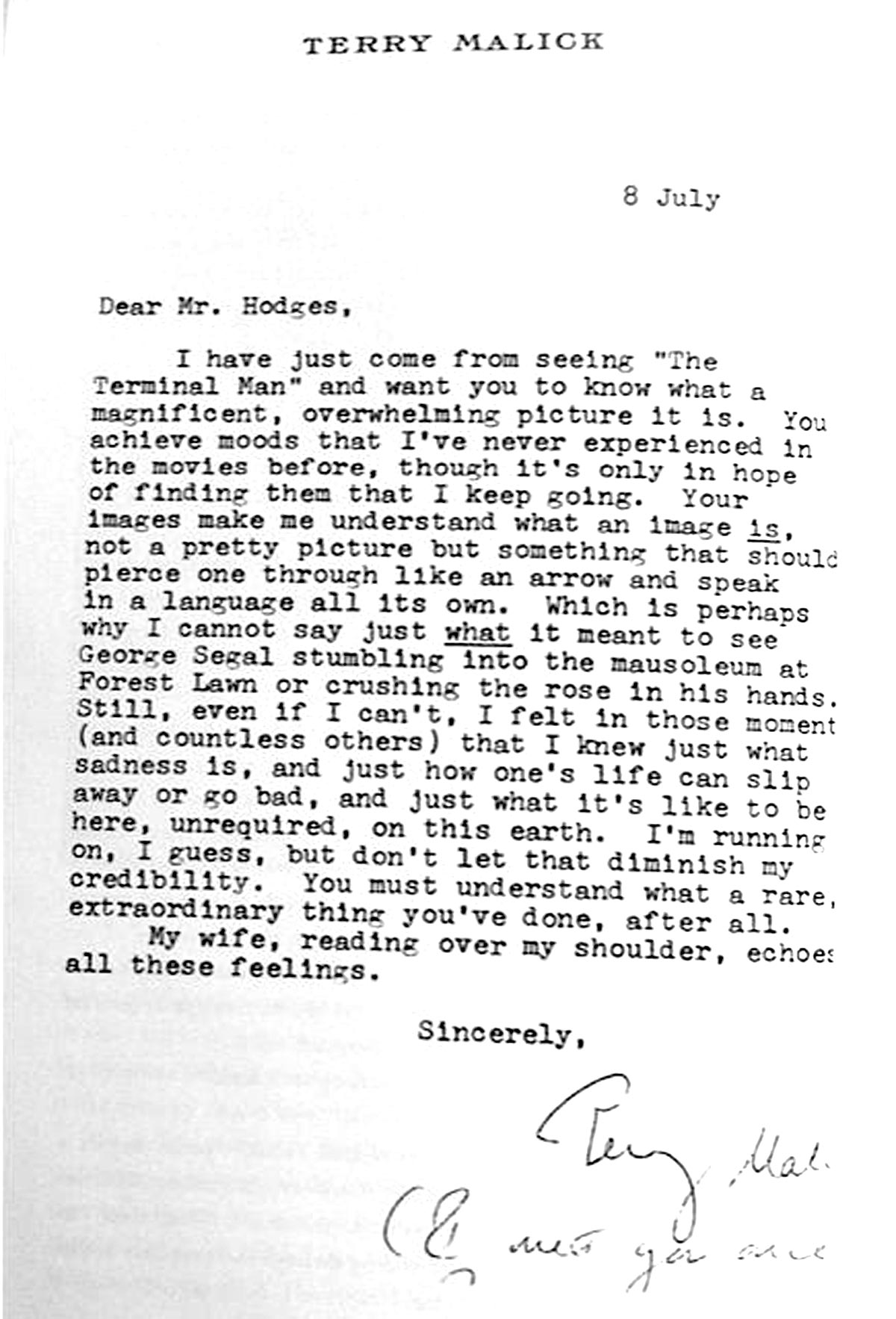
For me, THE ANDROMEDA STRAIN and THE TERMINAL MAN are essential works of early-to-mid 1970’s science fact/fiction cinema and classics of slo-burn expository horror/suspense. I suppose, you could watch them on your iPhone or iPad… in the comfort of your own toilet… but, there is a far more preferable option: both films screen (as nature intended them) in 35mm on Friday & Saturday, July 21 & 22, 2017 at the New Beverly Cinema.


